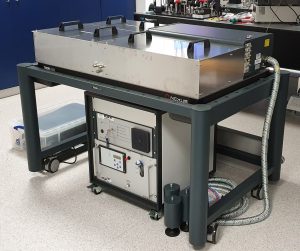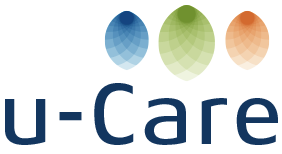
The tuneable UV source.
Photo courtesy of Professor John Travers.
This part of the project aims to develop tunable ultrashort pulses of light in the vacuum ultraviolet (known as VUV, 100-200nm) and deep ultraviolet (DUV, 200-300nm) for use in ultrafast spectroscopy, technology, and healthcare applications. The team exploited a phenomenon known as resonant dispersive wave emission using gas-filled hollow-core capillary fibres to achieve this.
Previously, deep ultraviolet light generation in hollow-core capillary fibres was achieved with very large-scale ultrafast laser amplifiers; however, Professor Travers and his team have now demonstrated that compact tabletop systems can be realised using industrialised pump lasers such as the Light Conversion Pharos system. In the last few weeks, the system was relocated from Heriot-Watt University to the U. of Edinburgh Queens Medical Research Institute, a move that represents a significant milestone for the EPSRC funded U-care project. It will now be used by the U-care interdisciplinary team to understand how DUV light interacts with human tissues and how safe it is for a variety of clinical applications.
“Back in 2015, when we started to develop this technique, if you wanted to get a deep UV light source that was this bright you had to visit a large synchrotron or free-electron laser facility or make use of very elaborate and expensive equipment”, John says “the only other deep UV sources were lamps, and while lamps are simple and low cost, they are not tunable and have exceedingly low brightness, completely unsuitable for the clinical applications we have in mind.”
While synchrotron facilities are available, they offer only very limited beam time, and require you to move your experiment to the synchrotron! This prohibits the kind of integrated, translational healthcare research that is being targeted by the U-care team. The key to solving this access issue was to exploit high-energy soliton dynamics.
“Our goal was to build a tabletop light source that had the same, or higher, brightness as a synchrotron. The first one we built was 10m long, but we wanted to see if we could get it down to a tabletop size, which we did. We ended up with a portable version and moved it from Heriot-Watt to the University of Edinburgh, where it comfortably sits in the Queens Medical Research Institute building (once we got it past the door frame).”
The robustness of the source remains to be seen, but for now, it sits proudly – as the record brightest deep UV light source that is both moveable and tuneable to multiple wavelengths.
You can download the paper by Christian Brahms and John Travers here.

